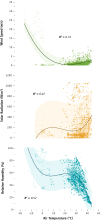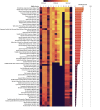Indicators to assess physiological heat strain - Part 3: Multi-country field evaluation and consensus recommendations
- PMID: 36249710
- PMCID: PMC9559325
- DOI: 10.1080/23328940.2022.2044739
Indicators to assess physiological heat strain - Part 3: Multi-country field evaluation and consensus recommendations
Abstract
In a series of three companion papers published in this Journal, we identify and validate the available thermal stress indicators (TSIs). In this third paper, we conducted field experiments across nine countries to evaluate the efficacy of 61 meteorology-based TSIs for assessing the physiological strain experienced by individuals working in the heat. We monitored 372 experi-enced and acclimatized workers during 893 full work shifts. We continuously assessed core body temperature, mean skin temperature, and heart rate data together with pre/post urine specific gravity and color. The TSIs were evaluated against 17 published criteria covering physiological parameters, practicality, cost effectiveness, and health guidance issues. Simple meteorological parameters explained only a fraction of the variance in physiological heat strain (R2 = 0.016 to 0.427; p < 0.001), reflecting the importance of adopting more sophisticated TSIs. Nearly all TSIs correlated with mean skin temperature (98%), mean body temperature (97%), and heart rate (92%), while 66% of TSIs correlated with the magnitude of dehydration and 59% correlated with core body temperature (r = 0.031 to 0.602; p < 0.05). When evaluated against the 17 published criteria, the TSIs scored from 4.7 to 55.4% (max score = 100%). The indoor (55.4%) and outdoor (55.1%) Wet-Bulb Globe Temperature and the Universal Thermal Climate Index (51.7%) scored higher compared to other TSIs (4.7 to 42.0%). Therefore, these three TSIs have the highest potential to assess the physiological strain experienced by individuals working in the heat.
Keywords: Occupational; core temperature; criteria; dehydration; heart rate; heat indices; heat strain; hyperthermia; labor; skin temperature; temperature; thermal indices; work.
© 2022 The Author(s). Published by Informa UK Limited, trading as Taylor & Francis Group.
Conflict of interest statement
No potential conflict of interest was reported by the authors.
Figures


Similar articles
-
Indicators to assess physiological heat strain - Part 2: Delphi exercise.Temperature (Austin). 2022 Mar 27;9(3):263-273. doi: 10.1080/23328940.2022.2044738. eCollection 2022. Temperature (Austin). 2022. PMID: 36211947 Free PMC article.
-
Indicators to assess physiological heat strain - Part 1: Systematic review.Temperature (Austin). 2022 Jul 31;9(3):227-262. doi: 10.1080/23328940.2022.2037376. eCollection 2022. Temperature (Austin). 2022. PMID: 36211945 Free PMC article. Review.
-
Working in hot conditions--a study of electrical utility workers in the northern territory of Australia.J Occup Environ Hyg. 2015;12(3):156-62. doi: 10.1080/15459624.2014.957831. J Occup Environ Hyg. 2015. PMID: 25265189
-
An Evaluation of the Physiological Strain Experienced by Electrical Utility Workers in North America.J Occup Environ Hyg. 2015;12(10):708-20. doi: 10.1080/15459624.2015.1043054. J Occup Environ Hyg. 2015. PMID: 26011148
-
Workers' health and productivity under occupational heat strain: a systematic review and meta-analysis.Lancet Planet Health. 2018 Dec;2(12):e521-e531. doi: 10.1016/S2542-5196(18)30237-7. Lancet Planet Health. 2018. PMID: 30526938
Cited by
-
Hot Pursuit: New Efforts to Prevent Heat-Related Illness on the Job.Environ Health Perspect. 2022 Sep;130(9):92001. doi: 10.1289/EHP11954. Epub 2022 Sep 12. Environ Health Perspect. 2022. PMID: 36094404 Free PMC article.
-
Beyond heat exposure - new methods to quantify and link personal heat exposure, stress, and strain in diverse populations and climates: The journal Temperature toolbox.Temperature (Austin). 2022 Dec 18;10(3):358-378. doi: 10.1080/23328940.2022.2149024. eCollection 2023. Temperature (Austin). 2022. PMID: 37554380 Free PMC article.
-
A scoping review on heat indices used to measure the effects of heat on maternal and perinatal health.BMJ Public Health. 2024 Feb 7;2(1):e000308. doi: 10.1136/bmjph-2023-000308. eCollection 2024 Jun. BMJ Public Health. 2024. PMID: 40018117 Free PMC article.
-
Indicators to assess physiological heat strain - Part 2: Delphi exercise.Temperature (Austin). 2022 Mar 27;9(3):263-273. doi: 10.1080/23328940.2022.2044738. eCollection 2022. Temperature (Austin). 2022. PMID: 36211947 Free PMC article.
-
The effect of the participatory heat education and awareness tools (HEAT) intervention on agricultural worker physiological heat strain: results from a parallel, comparison, group randomized study.BMC Public Health. 2022 Sep 15;22(1):1746. doi: 10.1186/s12889-022-14144-2. BMC Public Health. 2022. PMID: 36104813 Free PMC article. Clinical Trial.
References
LinkOut - more resources
Full Text Sources
Other Literature Sources
